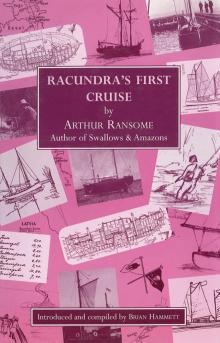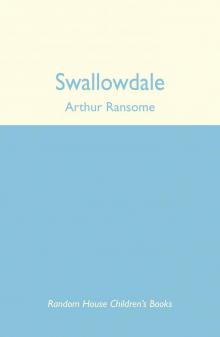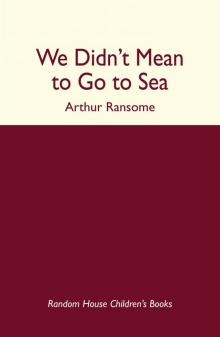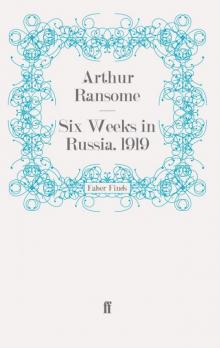- Home
- Arthur Ransome
Racundra's First Cruise
Racundra's First Cruise Read online
RACUNDRA’S
FIRST
CRUISE
Arthur Ransome Societies
The Arthur Ransome Society was founded in 1990 with the aim of promoting interest in Arthur Ransome and his books. For more information on the Society visit their website at www.arthur-ransome.org.uk
In 1997 members of the Society formed The Nancy Blackett Trust with the intention of purchasing and restoring one of Ransome’s own yachts, the Nancy Blackett, and using her to inspire interest in the books and to encourage young people to take up sailing. She now visits many classic boat shows around the country.
To find out more about the trust, or to contribute to the upkeep of the Nancy Blackett please visit their website at www.nancyblackett.org
The Arthur Ransome Trust was formed in 2010, and is dedicated to helping people discover more about Arthur Ransome’s life and writing, primarily through the development of a dedicated Ransome Centre in the southern Lake District. For more information on the Trust please visit their website at www.arthur-ransome-trust.org.uk
RACUNDRA’S
FIRST
CRUISE
by Arthur Ransome
Introduced and compiled
by Brian Hammett
This edition first published in 2015 by Fernhurst Books Limited
62 Brandon Parade, Holly Walk, Leamington Spa, Warwickshire, CV32 4JE, UK
Tel: +44 (0) 1926 337488 | www.fernhurstbooks.com
Text and pictures © The Arthur Ransome Literary Estate
Introduction © Brian Hammett
First edition published in 1923 by George Allen & Unwin Ltd., London
All rights reserved. No part of this publication may be reproduced, stored in a retrieval system or transmitted, in any form or by any means, electronic, mechanical, photocopying, recording, scanning or otherwise, except under the terms of the Copyright, Designs and Patents Act 1988 or under the terms of a license issued by The Copyright Licensing Agency Ltd, Saffron House, 6-10 Kirby Street, London, EC1N 8TS, UK, without the permission in writing of the Publisher.
Designations used by companies to distinguish their products are often claimed as trademarks. All brand names and product names used in this book are trade names, service marks, trademarks or registered trademarks of their respective owners. The Publisher is not associated with any product or vendor mentioned in this book.
ISBN 978-1-909911-23-9 (paperback)
ISBN 978-1-909911-59-8 (eBook)
ISBN 978-1-909911-60-4 (eBook)
Artwork by Creative Byte
Cover design by Simon Balley
RACUNDRA’S FIRST CRUISE
This edition of Racundra’s First Cruise includes the original maps, text and photographs from the 1923 edition. Details of Ransome’s first attempts at Baltic sailing, in his two previous boats Slug and Kittiwake, are included in the introduction.
ARTHUR RANSOME ON THE BUILDING OF RACUNDRA
“I took a deep breath and signed the contract. This was among the few wise things I have done in my life, for, more than anything else, this boat helped me to get back to my proper trade of writing.”
BRIAN HAMMETT
Brian Hammett has compiled this edition of Racundra’s First Cruise. The preface leads us into a treasure trove of unpublished writings, essays and photographs. The life of Ransome’s beloved Racundra is chronicled to its conclusion and there is an explanation of how he came to write the book. The original illustrations are enhanced by the inclusion of present-day photographs of the same locations. Brian Hammett researched the introduction by following Racundra’s route through Latvia and Estonia in his 33 foot gaff cutter AVOLA.
CONTENTS
Preface
Page
Introduction
9
Slug
13
Kittiwake
24
Racundra
39
The writing of Racundra’s First Cruise
51
On the Pirate Ship
53
Racundra’s First Cruise
62
Appendix – A Description of Racundra
239
Racundra after Ransome
243
Chronology
251
Bibliography
254
Acknowledgements
256
ARTHUR RANSOME, MASTER AND OWNER.
EVEGENIA SHELEPINA, COOK.
Aug 26. 1924
Racundra,
River Aa.
A man who owns a little ship
Must be forgiven many a slip
Committed when on shore.
A wife in every foreign port
Is unto him accounted naught;
And shall a book count more?
A borrowed book that’s not at hand,
Being, for safety’s sake, on land
Seems but a trivial slip;
As for your promised day in Heaven,
He’s used to have his weekly seven
For Heaven is his ship.
But when at last his sails are furled
And he is once more in the world
Where little things count much,
An aeroplane with swiftest flight
Shall bear the book back to delight
It’s owner’s greedy clutch.
This poem was written during Racundra’s third and last cruise under Ransome’s ownership. Bridget Sanders, W. G. Collingswood’s granddaughter, wrote in autumn 1997: “This poem was sent to Dr. John Rickman at 11 Kent Terrace, Regent’s Park, London NW1, who must have been badgering AR for a book he had lent him. John Rickman was a distinguished psychoanalyst, and pupil of Freud’s.”
INTRODUCTION
“I ... took a deep breath and signed the contract. This was among the few wise things I have done in my life, for, more than anything else, this boat helped me to get back to my proper trade of writing.”
Arthur Ransome (1884 – 1967), famous in later life as a children’s author, wrote those words in 1922, having just committed himself to the building of his boat Racundra. The maiden voyage took place from 20th August 1922 until 26th September from Riga, in Latvia, to Helsingfors (Helsinki), in Finland, via the Moon Sound and Reval (Tallinn) in Estonia and back. On completion of the trip he wrote and published his first really successful book, Racundra’s First Cruise.
I am delighted to have the opportunity to introduce a completely new edition of Ransome’s first book on sailing. The original text of the first edition, of which only 1500 copies were printed, has been used in its entirety with the original layout. The original 30 photographs, and four sketch charts, are included together with more unpublished Ransome pictures and recent photographs of many of the places visited during the cruise.
The book has been out of print for many years; the last edition was a paperback published in 1984 by Century Publishers, London, and Hippocrene Books, New York, containing charts but no photographs. The story of how he came to write the book and his sailing activities in the Baltic in the early 1920s makes fascinating reading and tells us a great deal about the man and his approach to sailing and writing.
Ransome went to Russia in 1913 following an unsuccessful first marriage and having successfully defended a court case for libel, by Lord Alfred Douglas, over his book Oscar Wilde, a Critical Study, published in 1912. He had a desire to learn Russian and research and translate Russian fairy tales. His book Old Peter’s Russian Tales was published in 1916. He was offered a job as a foreign correspondent and journalist by the Daily News and later the Manchester Guardian. He reported extensively on Russian matters, the First World War, and the aftermath of the October Revolution. Whilst in Russia he met and fell in
love with Evgenia Shelepina, Trotsky’s secretary. They lived together as lovers up until the time that Ivy, his first wife, agreed to a divorce. They married at the British consulate in Reval (Tallinn) on the 24th May 1924.
PETER THE GREAT’S PLAN FOR BALTIC PORT.
Ransome was a prolific writer and had already published 23 books by 1920. The most successful of his books were Bohemia in London, 1907, A History of Story Telling, 1909, and Old Peter’s Russian Tales, 1916. He had also written two literary critical studies: one on Edgar Alan Poe, 1910, and another on Oscar Wilde, 1912. His life has been extremely well documented in his autobiography, his biography (by Hugh Brogan), and in other books by Christina Hardyment, Roger Wardale, Jeremy Swift and Peter Hunt. A literary society, the Arthur Ransome Society, TARS, is very active and his most famous boat Nancy Blackett (alias Goblin) is run by a charitable trust.
Having had a lifetime interest in Ransome’s work, and having sailed in the Baltic in the year 2000 (where I used Racundra’s First Cruise as a pilot book on several occasions), I was interested in discovering more about Ransome’s Baltic sailing and to find out why and how he came to write Racundra’s First Cruise. I was amazed by the accuracy of his description of Racundra’s sailing area. The instructions for navigating the coasts of Latvia and Estonia, and in particular the Moon Sound, were as useful and accurate today as they were in the 1920s. The details of port and harbour entry and refuge anchorages also hold good today. Indeed, at one stage in our trip we “happened upon” Baltic Port (now called Paldiski North) whilst running for shelter from a southwesterly gale. We immediately recognised the description of the harbour. Once we had moored up the harbourmaster made us most welcome, told us that we could shelter for as long as we liked, at no charge, and even sent someone to sweep the quay where we had moored. This mirrored the treatment Ransome had experienced 78 years earlier. The harbourmaster and his colleague, the director of Paldiski Port, were very interested in the chapter Old Baltic Port and New in Racundra’s First Cruise and, in exchange for a copy, gave us a pamphlet in Russian showing the original plans that Peter the Great had for the area. Ransome mentions on several occasions the uncompleted causeway and the old fort, both of which still exist today.
Ransome’s background as an author and a journalist meant that, by nature, he was a compulsive writer. He kept diaries, logbooks, typed and handwritten notes and full details of his interests and activities. Most of this information still survives, mainly in the Brotherton Library at the University of Leeds.
Ransome’s time in the Baltic up to 1920 had been fully occupied on journalistic activities and political writings of one sort or another although he was fiercely apolitical. In 1920 he and Evgenia had decided to live in Reval (Tallinn), Estonia, where he spent less time reporting and more time writing in-depth articles for the Manchester Guardian. This change of direction in his work activity meant that he was able to enjoy a little more free time to pursue his favourite pastime, fishing. Ransome had sailed a little on Coniston Water, in the Lake District, with his friend Robin Collingwood, son of W.G. Collingwood (the Lakeland poet and writer, a father figure to Ransome after the death of his own father when Arthur was only 13). This introduction to sailing appears to have whetted his appetite for the sport, although in 1920 he considered himself very much a novice. However, he was to learn his skills very quickly.
To set the background for Racundra and Racundra’s First Cruise it is important that we look briefly at his previous boats: Slug in 1920 and Kittiwake in 1921. This period of Ransome’s life has been covered in his autobiography, published in 1976, and in his biography by Hugh Brogan, published in 1984. His early sailing is portrayed somewhat differently in his unpublished notes and writings. In looking at Ransome’s work, shown in American Typewriter font, I have reproduced it exactly as originally written. In the 1920s many of the locations mentioned had different names and I have shown the current names in brackets.
In Peter Hunt’s book Approaching Arthur Ransome, he criticises Racundra’s First Cruise as “a curious volume: it is a specialist work, full of small details of what was a relatively uneventful cruise and many pages of minutiae of sailing and rigging and navigation, which are largely incomprehensible to the layperson.... Ransome leavened the account of sailing in Racundra with encounters ashore, and possibly because they are padding and not focused on his dominant interest at the time, some are in the worst possible manner – pseudo-symbolic, inconsequential, and rather pretentious. (An example ... The Ship and the Man, first published in the Manchester Guardian in 1922).... One of the features of Racundra’s First Cruise is that it seems almost a sequel, or a book written for people intimately acquainted not just with sailing, but with Ransome’s life. Old friends, in the form of boats as well as people, continually crop up, scarcely introduced. Kittiwake and Slug are referred to as though we knew them well.”
This was possibly a justified criticism. However, by looking at Ransome’s original material from 1920 and 1921 we can see how he came to include some of his previous experiences in Racundra’s First Cruise.
SLUG
Ransome and Evgenia had moved to Reval (Tallinn) in 1919 and, after recovering from a bout of illness (he suffered badly from stomach ulcers all his life), they moved to Lodenzee in Lahepe Bay about 40 miles from Reval (Tallinn). Here they rented rooms in a house with a quiet room where he could write. When shopping in Reval (Tallinn) Ransome always strolled round the harbour looking for something with a mast and sail. He recalls:
(Autobiography) In the end, walking one day along the beach, I came upon a man putting a lick of green paint on a long, shallow boat with a cut-off transom that had once carried an outboard motor. She had a mast. She was for sale. On the beach beside her were large round boulders. I prodded her here and there and asked her price. The man named a sum that sounded enormous in Esthonian marks but when translated into English money came to something under ten pounds. The price included the boulders on the beach.... I bought that boat.... I found Evgenia, told her what I had done and said I would sail the boat from Reval to Lahepe next day. Evgenia, full of quite unjustified faith in me as a mariner, said that she was coming too.
The boat proved so slow that they christened her Slug. His autobiography chronicles in detail the maiden voyage to Lahepe Bay, including his diving overboard for a swim, and the difficulty he had getting back on board when the wind came up and Slug started sailing off to Finland with Evgenia in command. He was able with a superhuman effort to get back on board via the bowsprit, a feat that he was never able to repeat. The same trip is portrayed somewhat differently in his typewritten Log of Slug. He leaves out any mention of the difficulties of returning on board, an episode of which he was no doubt ashamed and wished to forget.
LOG OF THE SLUG
1920
6 a.m. Sunday July 3.
Dead calm. However, we packed our bags and went down to the pier, determined to get out of Reval no matter if only a little way, rather than postpone the start another day. At 6.30, though the water was like glass in the bay, there were occasional catspaws from the northwest. The scoundrel, who came to his pier head to see us off, said he was sure there would be wind of some sort, but the devil only could tell from what quarter. We hoisted sail, and had just enough wind to get us out past the bank of rocks that lies immediately north of the boat piers some few hundred yards from the land. Again dead calm. Thought of bathing from these rocks, but found them surrounded by piles, making approach impossible. Drifted. A very light wind from northwest filled our sail again, and we took a course north northwest. The wind was so slight and we moved so slowly that after tying a bottle to a rope and letting out astern, in case any gust should move her to unexpected hurry, I dived overboard and had a swim. Got on board again, and about seven thirty there was enough wind to give her yard or two of wake. We held on our course, the wind steadily getting a little stronger, till close inshore, north of the mill and south of the wooden pier at Miderando. We were passed by the tw
o masted sailing boat which we had thought of buying the previous day. South of the pier we went about, and with a pleasant but very light wind sailed west northwest making for the southern end of Nargon Island, a run of about eight and half a miles. With great delight we picked up the various buoys marked on our chart, and ran into the little bay southwest of the point, where we grounded the boat, landed, made a fire, and boiled up some cold tea. During the war, landing on Nargon was prohibited, and as we were not sure of our rights, we did not go as we had first intended to the village half a mile away to get milk, but lay low, and did not leave the shore. From where we made tea, we could just see the Surop lighthouse on the Esthonian coast.
SLUG ON REVAL BEACH.
Looking towards Reval, we saw a heavy black sky coming up from the east, and heard thunder. Presently the wind dropped to nothing. Then rose suddenly from the east, and we decided to lose no time, but to run for Surop, and try to get across before the worst of the storm should reach us, as we were on a beach exposed to the east, and could see nothing but rocky coast to the west. We got aboard at 4.30, and took a course southwest for the Surop lighthouse, thinking to shelter from the storm on the western side of Cape Ninamaa. But the storm was upon us before we were two miles on this slant of six. At least, not the storm but the wind. We had only a drop or two of rain, though the whole Esthonian coast east of Surop disappeared altogether in a dark cloud threaded by lightning. The sea turned black and then white in a moment, and the wind fairly lifted our little boat along, so that we were very grateful for the good stone ballast, which our scoundrel friend had stowed in her for the voyage. She stood it beautifully. And we were sorry for a much larger boat, beating up for Reval clear into the storm, which bowed her nearly flat to the water. The wind dropped as suddenly as it rose. The storm blotted out Nargon behind us, and passed, and we sailed slowly by Surop lighthouse, recognising it from our chart, as a white round tower surrounded by trees, at about seven o’clock.

 Peter Duck: A Treasure Hunt in the Caribbees
Peter Duck: A Treasure Hunt in the Caribbees Racundra's First Cruise
Racundra's First Cruise Great Northern?
Great Northern? Swallowdale
Swallowdale Swallows and Amazons
Swallows and Amazons Winter Holiday
Winter Holiday Missee Lee: The Swallows and Amazons in the China Seas
Missee Lee: The Swallows and Amazons in the China Seas Pigeon Post
Pigeon Post We Didn't Mean to Go to Sea
We Didn't Mean to Go to Sea The Firebird and Other Russian Fairy Tales
The Firebird and Other Russian Fairy Tales Coot Club
Coot Club The Big Six: A Novel
The Big Six: A Novel Six Weeks in Russia, 1919
Six Weeks in Russia, 1919 Secret Water
Secret Water The Big Six
The Big Six Missee Lee
Missee Lee Peter Duck
Peter Duck The Picts and the Martyrs
The Picts and the Martyrs